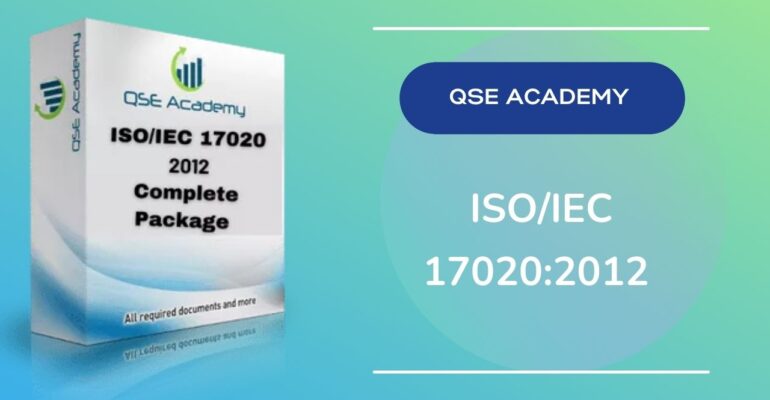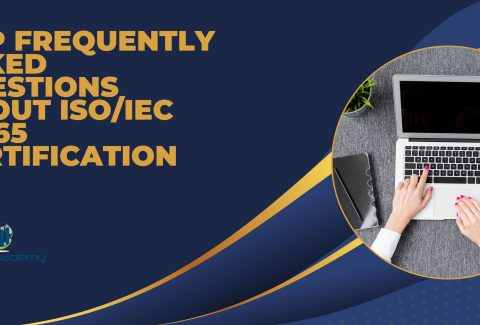What is ISO/IEC 17020 accreditation?
Introduktion
ISO/IEC 17020 is an international standard that specifies requirements for the competence of bodies performing inspection methods and for the impartiality and consistency of their inspection activities. It is applicable to inspection bodies of all types, regardless of the sector in which they operate. Inspection bodies play a crucial role in various industries by providing an independent assessment of the integrity and quality of products, services, processes, and installations. These assessments help ensure compliance with regulatory requirements, industry standards, and customer specifications.
This article aims to provide a comprehensive overview of ISO/IEC 17020 accreditation, including its definition, key principles, types of inspection parameters, accreditation process, benefits, challenges, and real-world examples. By understanding these aspects, organizations can better appreciate the value of ISO/IEC 17020 accreditation and take steps to achieve and maintain it.
1. Understanding ISO/IEC 17020
Definition and Scope
ISO/IEC 17020 is a standard developed by the International Organization for Standardization (ISO) and the International Electrotechnical Commission (IEC). It outlines the requirements for the operation of various types of inspection bodies, including those performing inspections in fields such as manufacturing, engineering, construction, and other technical areas. The scope of ISO/IEC 17020 includes criteria for ensuring impartiality, competence, and consistent operation of inspection agencies.
Historical Background
ISO/IEC 17020 was first published in 1998 and has undergone several revisions to keep pace with evolving industry practices and technological advancements. The most recent version was published in 2012, reflecting significant updates to improve the clarity of requirements and address new challenges faced by inspection agencies. The standard has become a benchmark for ensuring high standards of inspection practices worldwide.
2. Key Principles of ISO/IEC 17020:2012
Impartiality and Independence
One of the core principles of ISO/IEC 17020:2012 is ensuring the impartiality and independence of inspection bodies. Impartiality means conducting inspections without bias or undue influence from stakeholders, ensuring that the results are objective and reliable. Measures to maintain independence include implementing policies and procedures that prevent conflicts of interest and ensure that the activities of inspection bodies are conducted transparently. Inspection bodies must demonstrate their commitment to impartiality by establishing policies and procedures that promote objectivity and avoid conflicts of interest. These measures may include implementing a code of conduct for their staff, adopting a transparent decision-making process, and maintaining a separation between inspection activities and any external influences.
To ensure impartiality, inspection bodies should establish procedures for identifying and managing potential conflicts of interest. This involves identifying any relationships, financial interests, or other circumstances that could compromise the objectivity of the inspection procedures. By having clear policies in place, inspection bodies can significantly reduce the risk of bias and ensure the credibility of their inspection results.
Another aspect of impartiality is the need for inspection bodies to be free from undue influence or pressure from stakeholders. This means that they should not be controlled, directly or indirectly, by the entities they inspect or any other interested party. By maintaining their independence, inspection bodies can make objective judgments based solely on the evidence collected during inspections.
Transparency is also crucial in ensuring impartiality. Inspection bodies must document their procedures, communicate them clearly to all stakeholders, and make them easily accessible. This transparency helps build trust and confidence in the inspection process, as stakeholders can understand how inspections are carried out and how decisions are made.
Competence
The competence of personnel performing inspections is crucial for the credibility of the inspection process. ISO/IEC 17020 requires inspection bodies to employ personnel with the necessary skills, knowledge, and experience to carry out inspections effectively. This includes establishing qualification criteria, providing ongoing training, and conducting regular assessments to ensure continuous professional development. ISO/IEC 17020 accreditation places a strong emphasis on the technical competence of personel involved in the inspection process. It recognizes that the quality and accuracy of inspection results depend heavily on the skills, knowledge, and experience of the individuals conducting the inspections.
To meet the requirements of ISO/IEC 17020, inspection bodies must establish qualification criteria for their personnel. This involves defining the educational background, training, and experience necessary for individuals to become qualified inspectors. By setting clear criteria, inspection bodies can ensure that their personnel possess the appropriate skills and knowledge to carry out inspections effectively.
In addition to establishing qualification criteria, ISO/IEC 17020 also emphasizes the importance of ongoing training and professional development for inspection personnel. Inspection bodies are required to provide regular training to their personnel to enhance their technical expertise and keep them up-to-date with industry advancements and changes in regulatory requirements.
Dessutom, ISO/IEC 17020 mandates that inspection bodies conduct regular assessments of their personnel to verify their competence. This may include performance reviews, competency tests, or observation of their work in the field. These assessments are essential to identify any gaps in knowledge or skills and to ensure that personnel maintain the necessary competence levels.
Krav på ledningssystem
Inspection bodies must establish a management system that supports the consistent delivery of high-quality inspection services. This includes maintaining comprehensive documentation and records of all inspection activities, implementing procedures for managing non-conformities, and continually improving the management system based on feedback and performance evaluations. Continuous improvement practices are essential for adapting to changing industry standards and client needs. In order to meet the requirements of ISO/IEC 17020 accreditation, inspection bodies must establish a robust and effective management system. This system plays a crucial role in ensuring the consistent delivery of high-quality inspection services.
One key aspect of the management system is the maintenance of comprehensive documentation and records of all inspection activities. This includes keeping detailed records of inspections conducted, observations made, tests performed, and any other relevant information. By documenting these activities, inspection bodies can provide evidence of their competence and adherence to established procedures.
Another important requirement is the implementation of procedures for managing non-conformities. Non-conformities are instances where the inspection process deviates from established procedures or where the inspection results are found to be inaccurate or unreliable. Inspection bodies must have systems in place to identify, investigate, and rectify these non-conformities in a timely manner. This helps to ensure the integrity and reliability of the inspection process.
Continuous improvement is also a critical aspect of the management system requirements. Inspection bodies are expected to continually evaluate their performance and seek feedback from clients and stakeholders. This feedback can be used to identify areas for improvement and implement necessary changes to enhance the quality and efficiency of the inspection process.
3. Types of Inspection Bodies
Type A Inspection Bodies
Inspection bodies of type A are third-party organizations that operate independently of the parties involved in the item being inspected. They provide the highest level of impartiality and are often used for regulatory compliance, certification, and other activities where independence is critical. Examples of Type A inspection bodies include independent testing laboratories and certification organizations. Type A inspection bodies play a crucial role in ensuring the integrity and trustworthiness of inspection processes. These organizations operate independently from the parties involved in the item being inspected, which allows them to provide the highest level of impartiality. This independence is particularly important in activities such as regulatory compliance and certification, where unbiased assessment is essential.
Independent testing laboratories are a common example of Type A inspection bodies. These laboratories specialize in conducting tests and providing analysis for a wide range of industries and sectors. They have the necessary expertise and equipment to perform accurate and reliable tests on samples, products, or materials. Their independence ensures that the results they provide are unbiased and can be trusted by clients and stakeholders.
Certification organizations are another example of Type A inspection bodies. These organizations assess conformity to standards or specific requirements and issue certifications to demonstrate compliance. They play a critical role in areas such as product quality, environmental management, occupational health and safety, and food safety. By operating independently, certification bodies can ensure that their assessments are fair and impartial, providing confidence in the certified entity’s compliance with applicable regulations and standards.
Type A inspection reports adhere to strict guidelines and standards to ensure the quality and integrity of their services. These guidelines include the requirements outlined in the ISO/IE C 17020 accreditation. This accreditation is a globally recognized standard designed for inspection bodies’ competence. It provides a framework for ensuring that these organizations meet internationally accepted criteria for impartiality, confidentiality, competence, and consistency in their inspection activities.
Type B Inspection Bodies
Type B inspection bodies are in-house inspection units that perform inspections for their parent organization. While they are part of the organization, they operate separately from the production and quality control functions to maintain impartiality. These bodies are typically used for internal quality assurance and compliance verification within the organization. Type B inspection bodies serve an essential role in ensuring the quality and compliance standards within an organization. These bodies conduct inspections and assessments to verify that the internal processes, products, and services meet the required standards and regulations.
Operating separately from the production and quality control functions helps to maintain impartiality and objectivity in their assessments. By having an independent and unbiased perspective, Type B inspection bodies can identify any non-conformities or areas for improvement within the organization. This allows the organization to address and rectify these issues before they become larger problems or affect the quality of their products or services.
The inspections conducted by Type B inspection bodies are crucial for internal quality assurance and compliance verification. By regularly inspecting and evaluating their own operations, organizations can ensure that they are meeting the necessary standards and regulations. This helps to enhance the organization’s overall performance, efficiency, and reputation.
In addition to internal quality assurance, Type B inspection bodies can also provide valuable feedback and recommendations to improve processes and practices within the organization. Through their expertise and knowledge, they can offer insights that lead to more efficient operations, better compliance with regulations, and higher-quality outputs.
Just like Type A inspection bodies, Type B inspection bodies also adhere to the principles outlined in the ISO/IEC 17020 standard. This standard provides a framework for the operation and management of inspection bodies, ensuring that they maintain competence, impartiality, and consistency in their inspection activities.
Type C Inspection Bodies
Type C inspection bodies offer inspection services to both their parent organization and external clients. While they may not provide the same level of independence as Type A bodies, they are structured to maintain impartiality in their inspection activities. Type C bodies are often involved in sectors such as construction, engineering, and manufacturing, where they inspect both internal and external projects. Type C inspection bodies play a crucial role in ensuring compliance and quality assurance for both their parent organization and external clients. These bodies are often found in sectors such as construction, engineering, and manufacturing, where inspections are required to ensure safety, adherence to regulations, and overall quality.
While Type C bodies may not have the same level of independence as Type A bodies, they still maintain a certain degree of impartiality in their inspection activities. This is achieved through the implementation of rigorous policies and procedures that ensure fairness and objectivity in the inspection process.
Type C bodies conduct inspections on both internal projects within their parent organization and external projects for their clients. By doing so, they help to ensure that the projects are executed according to the required standards, regulations, and specifications. This helps to prevent potential risks and issues that may arise from non-compliance.
These inspection bodies employ qualified and experienced personnel who possess the necessary expertise and knowledge to carry out inspections effectively. They conduct thorough inspections, evaluate compliance, and provide valuable feedback to the organization or client. This feedback can be used to improve processes, identify potential areas of improvement, and enhance overall performance.
One of the key advantages of using Type C inspection bodies is the assurance of impartiality. By conducting inspections independently, Type C inspection bodies provide a level of impartiality that is vital in ensuring the integrity and credibility of inspections. By operating independently from the organizations they serve, Type C bodies can conduct inspections with objectivity and fairness, free from any potential conflicts of interest.
4. Accreditation Process
Application for Accreditation
The accreditation process begins with the submission of an application to an accreditation body. The application includes detailed information about the inspection body’s operations, procedures, and compliance with ISO/IEC 17020 requirements. Documentation such as quality manuals, procedural documents, and records of past inspections must be provided for review.
Assessment and Evaluation
The accreditation body conducts a thorough assessment of the inspection body’s management system and inspection processes. This includes on-site assessments and audits to verify the implementation of documented procedures and the competence of personnel. The assessment team evaluates the effectiveness of the management system, the impartiality of inspection activities, and the competence of the inspection staff.
Decision and Granting Accreditation
Based on the findings of the assessment, the accreditation body makes a decision regarding the accreditation status of the inspection body. If the inspection body meets all the requirements of ISO/IEC 17020, accreditation is granted, and an accreditation certificate is issued. This certificate is valid for a specified period, typically three to five years, during which the inspection body must maintain compliance with the standard.
Surveillance and Reassessment
To ensure continued compliance, the accreditation body conducts regular surveillance audits and periodic reassessments. These activities involve reviewing the inspection body’s ongoing operations, addressing any non-conformities identified during audits, and verifying the implementation of corrective actions. Maintaining accreditation status requires continuous adherence to ISO/IEC 17020 requirements and a commitment to ongoing improvement.
5. Benefits of ISO/IEC 17020 Accreditation
Enhanced Credibility and Trust
ISO/IEC 17020 accreditation enhances the credibility and trustworthiness of inspection bodies. Accredited inspection bodies are recognized for their impartiality, competence, and consistent performance, which builds confidence among clients, regulatory bodies, and stakeholders. This credibility is particularly important in industries where safety, quality, and compliance are critical.
Förbättrad operativ effektivitet
Accreditation drives operational efficiency by promoting standardized procedures and best practices. Inspection bodies can streamline their processes, reduce errors, and improve the reliability of inspection results. Efficient operations lead to cost savings, better resource utilization, and increased client satisfaction.
Regulatory Compliance
ISO/IEC 17020 accreditation helps inspection bodies meet regulatory requirements and industry standards. Accredited bodies are better positioned to navigate complex regulatory environments, facilitating easier access to international markets and reducing the risk of non-compliance penalties. This compliance also enhances the inspection body’s reputation and competitive advantage.
6. Challenges in Achieving ISO/IEC 17020 Accreditation
Tilldelning av resurser
Achieving ISO/IEC 17020 accreditation requires significant resources, including financial investment, time, and personnel. Inspection bodies must allocate adequate resources to develop and maintain their management systems, conduct training, and prepare for assessments. Balancing accreditation efforts with regular operations can be challenging, especially for smaller organizations.
Maintaining Impartiality
Ensuring impartiality is a continuous challenge for inspection bodies. Potential conflicts of interest must be identified and managed effectively to maintain the integrity of inspection activities. Implementing robust policies and procedures to prevent bias and undue influence is essential for sustaining impartiality.
Kontinuerlig förbättring
Continuous improvement is a key requirement of ISO/IEC 17020, but implementing and sustaining improvement practices can be difficult. Inspection bodies must regularly review their processes, address feedback and internal audit findings, and adapt to changing industry standards. This requires a proactive approach to quality management and a commitment to ongoing development.
Slutsats
ISO/IEC 17020 accreditation is a rigorous process that ensures inspection bodies operate with competence, impartiality, and consistency. The standard outlines requirements for management systems, personnel competence, and impartial inspection activities. Understanding the accreditation process, the benefits, and the challenges involved is crucial for inspection bodies seeking to achieve and maintain accreditation.
ISO/IEC 17020 accreditation provides numerous benefits, including enhanced credibility, improved operational efficiency, and regulatory compliance. For inspection bodies, achieving and maintaining accreditation is a mark of excellence that builds trust with clients and stakeholders. It demonstrates a commitment to quality and continuous improvement, positioning the inspection body as a leader in its field.
Letar du efter fler resurser om ISO 17020?
Om du tyckte att den här artikeln var till hjälp kan du utforska våra premiumresurser som är utformade för att hjälpa dig att uppnå ISO 17025-certifiering på ett effektivt sätt:
- 📦 Komplett dokumentationspaket för ISO/IEC 17020 2012: Få alla viktiga mallar och dokument du behöver för en snabb och enkel implementering.
- 🎓 Onlinekurs om ISO/IEC 17020 2012 : Delta i vår omfattande utbildning för att lära dig de viktigaste begreppen och de praktiska stegen mot certifiering.
- 📋 ISO/IEC 17020 2012 Checklista: Ladda ner vår detaljerade checklista för att säkerställa att du har täckt varje steg i processen.
Dessa resurser är skräddarsydda för att tillgodose dina behov och säkerställa en smidig certifieringsresa. Utforska dem redan idag och kom ett steg närmare framgång!













